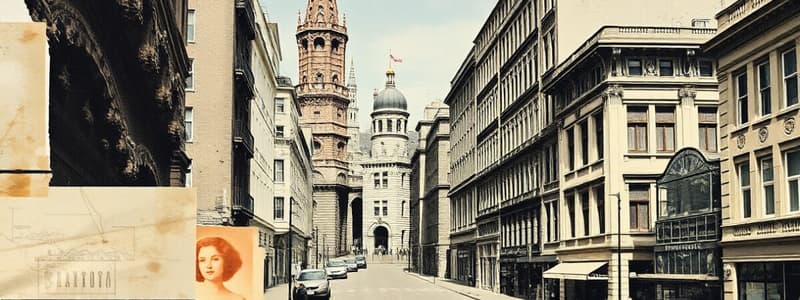Podcast
Questions and Answers
Which characteristic describes the outline or surface configuration in architecture?
Which characteristic describes the outline or surface configuration in architecture?
- Texture
- Size
- Color
- Shape (correct)
Which color scheme consists of colors that are next to each other on the color wheel?
Which color scheme consists of colors that are next to each other on the color wheel?
- Tetradic
- Analogous (correct)
- Triadic
- Complementary
What is the term for a space that serves as a transition between different areas?
What is the term for a space that serves as a transition between different areas?
- Transitional Space (correct)
- Exit
- Resting Area
- Common Space
Which of the following color properties defines how light or dark a color is?
Which of the following color properties defines how light or dark a color is?
Which of these architects is known for their innovative designs and contributions to modern architecture?
Which of these architects is known for their innovative designs and contributions to modern architecture?
Flashcards
Descriptive theory
Descriptive theory
A descriptive theory simply explains events or phenomena without trying to prove them.
Shape
Shape
The outline or surface configuration of an object.
Transitional space
Transitional space
A transitional space is an area that connects two different spaces, often used as an entrance.
Complementary colors
Complementary colors
Signup and view all the flashcards
Color property: Tint
Color property: Tint
Signup and view all the flashcards
Study Notes
Theory of Architecture Exam
- Descriptive theory: Explains events or phenomena
- Illustrative theory: Provides examples of phenomena
- Expressive theory: Shows the surface configuration of a form
- Prescriptive theory: Outlines a set of rules or instructions
Street Arrangement
- Parallel street arrangement: A common arrangement seen in many cities
- Grid street arrangement: A street design with streets organized in a grid system
- Radial street arrangement: Designed with streets radiating outward from a central point
- Network street arrangement: Streets are connected in a complex web-like form
Architectural Design
- Frank Lloyd Wright: A famous architect
- Le Corbusier: A famous architect
- I.M. Pei: A famous architect
- Philip Johnson: A famous architect
Color Theory
- Complementary colors: Colors that are opposite each other on the color wheel (e.g., red and green, violet and yellow) and that create a high contrast
- Value: The lightness or darkness of a color
- Tint: A color made lighter by adding white
- Shade: A color made darker by adding black
- Chroma: Represents the purity or intensity of a color
Three-Dimensional Forms
- Sound: A non-visual, auditory form.
- Casts shadow: A visible three-dimensional form created by an object blocking light.
- Movement: A three-dimensional form that moves or changes position over time.
- Length, width, and height: Three-dimensional characteristics that describe spatial dimensions.
Color Schemes
- Tetradic: Uses four colors that are evenly spaced around the color wheel.
- Triadic: Uses three colors that are evenly spaced around the color wheel.
- Analogous: Uses three colors that are next to each other on the color wheel.
- Complementary: Uses two colors that are opposite each other on the color wheel.
Architectural Approach
- Oblique approach: An approach at an angle
- Parallel approach: An approach in a straight line side-by-side
- Frontal approach: A straight approach, facing the front of a structure
- Spiral approach: An approach that winds around the structure
Studying That Suits You
Use AI to generate personalized quizzes and flashcards to suit your learning preferences.




